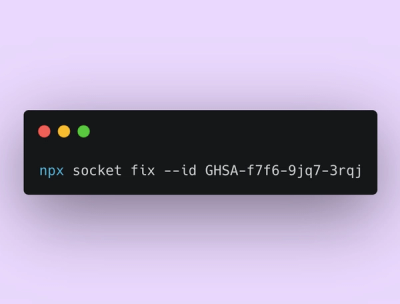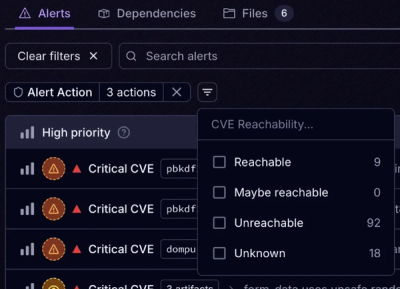
Product
Announcing Socket Fix 2.0
Socket Fix 2.0 brings targeted CVE remediation, smarter upgrade planning, and broader ecosystem support to help developers get to zero alerts.
dumb-deploy
Advanced tools
Simple application deployment for side projects
This is a stupid script I use to deploy applications to a remote web server for my side projects with minimal hassle/setup - on a budget!
$ yarn add dumb-deploy
Here's an example for deploying a containerized docker app:
const deploy = require("dumb-deploy");
/**
* downCmd should kill any previous instances of the app.
* Be agressive. We don't provide any context to the previous deployment.
* Be careful not to kill other applications running on the server.
* (Don't worry about cleaning up the directory, we'll do that for you.)
*/
async function downCmd() {
return `docker ps -a --filter="name=nginx" --format "{{.ID}}" | xargs -I{} docker rm --force "{}"`;
}
/**
* Start the application. Process should not run in the foreground.
*/
async function upCmd({ deployPath }) {
// https://docs.docker.com/compose/production/#deploying-changes
return `cd ${deployPath} && docker-compose up --no-deps -d nginx`;
}
async function main() {
await deploy({
// Specify a directory-friendly name for this app
appName: "nginx",
// Path to the root of your app
appDir: path.join(__dirname, ".."),
downCmd,
upCmd,
// user/host of the webserver
user: "mark",
host: "1.2.3.4",
// Where should we deploy applications to on the host?
prodRoot: "/home/mark/prod",
// Path to an SSH key that we can SSH into the server with
sshId: "/Users/mark/.ssh/deploy",
});
}
main();
Here's another example for a NodeJS app:
deploy/deploy.js:
const deploy = require("dumb-deploy");
const path = require("path");
async function downCmd({ deployPath }) {
return path.join(deployPath, "deploy", "down.sh");
}
async function upCmd({ deployPath }) {
return path.join(deployPath, "deploy", "up.sh");
}
async function main() {
await deploy({
// Specify a directory-friendly name for this app
appName: "api_server",
// Path to the root of your app
appDir: path.join(__dirname, ".."),
downCmd,
upCmd,
// user/host of the webserver
user: "mark",
host: "1.2.3.4",
// Where should we deploy applications to on the host?
prodRoot: "/home/mark/prod",
// Path to an SSH key that we can SSH into the server with
sshId: "/Users/mark/.ssh/deploy",
});
}
main();
deploy/down.sh:
#!/bin/bash
set -euo pipefail
# https://stackoverflow.com/a/246128/4396258
DIR="$( cd "$( dirname "${BASH_SOURCE[0]}" )" >/dev/null 2>&1 && pwd )"
ROOT="${DIR}/.."
# Brutally clean up all old instances of the app running under forever. Life's too short for gracefulness.
# (Make sure to grep filter for our app specifcially tho, to avoid killing other apps running on this server)
ps aux | grep forever | grep build/index.js | awk '{print $2}' | xargs -I{} kill -9 {} || true
lsof -i :44525 | grep node | awk '{print $2}' | xargs -I{} kill -9 {} || true
deploy/up.sh:
#!/bin/bash
set -euo pipefail
# https://stackoverflow.com/a/246128/4396258
DIR="$( cd "$( dirname "${BASH_SOURCE[0]}" )" >/dev/null 2>&1 && pwd )"
ROOT="${DIR}/.."
# run commands from the deploy dir root
pushd "${ROOT}"
make build
NODE_ENV=production yarn start
deploy.js scriptI'll appeal to authority: The Good Parts of AWS :
A problem we often see is that people sometimes mistake Lambda for a general-purpose application host. Unlike EC2, it is very hard to run a sophisticated piece of software on Lambda without making some very drastic changes to your application and accepting some significant new limitations from the platform.
Treating Lambda as a general-purpose host for your applications is risky. It might look compelling at first—no servers to manage, no operating system to worry about, and no costs when unused—but Lambda’s limitations are insidious hidden risks that typically reveal themselves once your application evolves into something bigger. Then, things start coming at you one after the other, and before you know it, you are spending most of your time trying to figure out convoluted solutions to Lambda’s numerous limitations.
(I'll avoid quoting further, you should definitely buy the book if you're doing anything with AWS.)
FAQs
**Simple application deployment for side projects**
We found that dumb-deploy demonstrated a not healthy version release cadence and project activity because the last version was released a year ago. It has 1 open source maintainer collaborating on the project.
Did you know?

Socket for GitHub automatically highlights issues in each pull request and monitors the health of all your open source dependencies. Discover the contents of your packages and block harmful activity before you install or update your dependencies.

Product
Socket Fix 2.0 brings targeted CVE remediation, smarter upgrade planning, and broader ecosystem support to help developers get to zero alerts.

Security News
Socket CEO Feross Aboukhadijeh joins Risky Business Weekly to unpack recent npm phishing attacks, their limited impact, and the risks if attackers get smarter.

Product
Socket’s new Tier 1 Reachability filters out up to 80% of irrelevant CVEs, so security teams can focus on the vulnerabilities that matter.